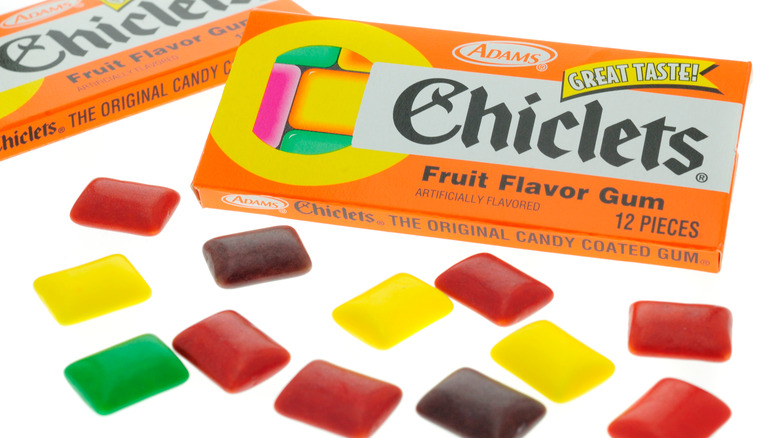American Chewing Gum Was Originally Marketed For Tires
Chewing gum has been around for a long, long time. Long before Orbit Gum's "Dirty mouth?" commercials, the ancient Greeks were chewing tree resin called mastich. The Mayans and Aztecs chewed chicle, which they harvested from the sapodilla tree, to alleviate thirst or hunger. There is also some evidence that 9,000 years ago, Europeans were chewing birch bark tar (per Smithsonian Magazine).
Gum has a few benefits, ones the ancient civilizations seemed to pick up on due to a lack of proper oral hygiene. Between meals, chewing gum is a great refresher; sugar-free gum might protect from cavities and fend off tooth decay caused by bacteria. Not only is it great for your mouth, but it can also reduce stress, improve focus, and reduce anxiety and depression. A study reported that participants were less hungry and less likely to indulge in carb-heavy snacks in the afternoon, while there is some proof that chewing gum while going for a walk might help you burn more calories. It's not without its problems either, with excessive chewing causing headaches and jaw problems, not to mention gum sweetened with sugar feeds the sugar-loving bacteria in your mouth (via Healthline).
But what we know today as chewing gum started out as something very different – as a rubber alternative for tires.
Chewing gum wasn't great at the start
In America, chewing gum was already kind of a thing in the 1840s, but it was flavorless and made with spruce resin, which was brittle and wasn't very nice to chew. Manufacturers switched to paraffin wax instead.
But along came the 1860s, and an American inventor, Thomas Adams Sr., came by some chicle via exiled Mexican president General Antonio Lopez de Santa Anna. Santa Anna was looking for a way to monetize chicle and get rich so he could return to Mexico. So the pair vulcanized the chicle in an attempt to make it into something a bit more robust and industrial, for tires. They failed, and Santa Anna moved on, but Adams kept experimenting. He boiled the chicle and rolled the resulting product into chewing gum balls – giving us Chiclets, per Candy Favorites.
William Wrigley gave gum away with large orders of soap, which helped chewing gum spread to the masses. The rest, as they say, is history (via History). Nowadays, the gum you chew is made with synthetic products, but Chicza, a Mexican chicle company focused on sustainable chicle harvesting, has launched its first products.

